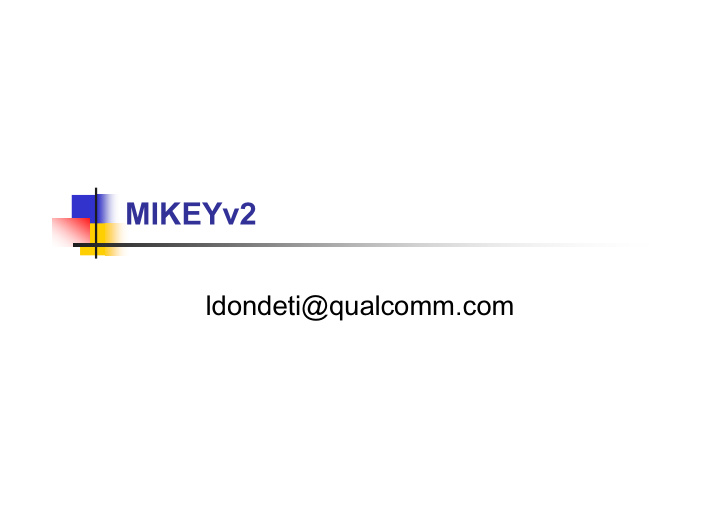



MIKEYv2 ldondeti@qualcomm.com
Why MIKEYv2? � MIKEY is an efficient key management protocol designed for SRTP keying � Used for broadcast keying in 3GPP and OMA � Easy to add crypto algorithm and mode negotiation � MIKEYv2 finishes in 1 RT in the media path � The code and design reuse argument applies to MIKEY as much as it applies to TLS � If some devices end up needing to implement MIKEYv2 in the smartcard, code reuse may become an important consideration IETF 68, Prague, March 2007 2
Properties of MIKEYv2 Peer-to-peer key management protocol � May be run in the signaling or media path � Finishes in 1 RT in the media path � Runs over UDP or multiplexed with RTP/RTCP � Supports crypto algorithm and mode negotiation � Supports unicast and broadcast keying � Establishes SRTP crypto context for multiple media streams � Can amortize the cost of public key operations over multiple � sessions Solves hunger, poverty, cancer, AIDS and other assorted problems � of the world IETF 68, Prague, March 2007 3
MIKEYv2 Message Flow Offerer Answerer Proxies Invite (O-fingerprint, MIKEYv2-Capabilities) Invite (…) MIKEYv2-Response MIKEYv2-Finish Offerer authenticated early media 200 OK (A-fingerprint) Answerer authenticated media ACK media IETF 68, Prague, March 2007 4
MIKEYv2 Capabilities Message � O � A: HDR, RANDi, CAP, IDi, CERTi, [IDr] � The CAP payload is new � The Initiator lists the crypto algorithms and MIKEY modes it supports � The Responder and the Initiator are expected to include this message in MAC IETF 68, Prague, calculation March 2007 5
MIKEYv2 Messages in Media Path MIKEYv2-PSK � � O � A: HDR, RANDi, RANDr, IDr, {SP}, KEMAC � O � A: HDR, RANDi, RANDr, [SP], V � MIKEYv2-RSA � O � A: HDR, RANDi, RANDr, IDr, [CERTr], {SP}, KEMAC, PKE, SIGNr � O � A: HDR, RANDi, RANDr, [SP], V � MIKEYv2-DH � O � A: HDR, RANDi, RANDr, [IDr|CERTr], {SP}, DHr, SIGNr � O � A: HDR, RANDi, RANDr, [SP], DHi, SIGNi � MIKEYv2-DHHMAC � O � A: HDR, RANDi, RANDr, IDr, {SP}, DHr, KEMACi � O � A: HDR, RANDi, RANDr, [SP], DHi, KEMACi IETF 68, Prague, March 2007 6
Why Can’t We Use DTLS-SRTP/ZRTP? � Have I already said we should build on MIKEY? ☺ � Desirable to use a single protocol for unicast and group keying? � Moving forward, not quite comfortable with some of the notions in the other choices � Does separation of keying and data encapsulation with TLS work well? � Is the client-server paradigm of TLS not an issue for peer-to- peer operation? � ZRTP is too chatty! � It is not clear when ZRTP finishes � Too many messages for SRTP establishment? IETF 68, Prague, March 2007 7
If We Must Use One of the Others � As few RTs as possible please � Support initiation via SDP � Make the protocol more peer-to-peer � Support for multiple sessions � I do think MIKEYv2 is the best option � But I can always pitch it to the WHO! ☺ � Solves hunger, poverty, cancer, AIDS and other assorted problems of the world IETF 68, Prague, March 2007 8
What do I Mean Peer-to-Peer? � DTLS-SRTP is a client-server protocol � Q: If new media sessions are initiated by the original answerer/client, would a new DTLS session be needed? � Many TLS extensions take this mode of operation into account � e.g., TLS session resumption IETF 68, Prague, March 2007 9
Recommend
More recommend